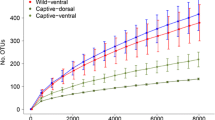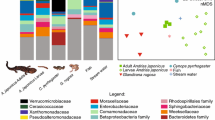Abstract
The rapid spread of infectious disease has resulted in the decline of animal populations globally. Amphibians support a diversity of microbial symbionts on their skin surface that help to inhibit pathogen colonisation and reduce disease susceptibility and virulence. These cutaneous microbial communities represent an important component of amphibian immune defence, however, very little is known about the environmental factors that influence the cutaneous microbiome. Here, we characterise the cutaneous bacterial communities of a captive colony of the critically endangered Australian southern corroboree frog, Pseudophyrne corroboree, and examine the effect of dietary carotenoid supplementation on bacterial abundance, species richness and community composition. Individuals receiving a carotenoid-supplemented diet exhibited significantly higher bacterial abundance and species richness as well as an altered bacterial community composition compared to individuals that did not receive dietary carotenoids. Our findings suggest that dietary carotenoid supplementation enhances the cutaneous bacteria community of the southern corroboree frog and regulates the presence of bacteria species within the cutaneous microbiome. Our study is the second to demonstrate that carotenoid supplementation can improve amphibian cutaneous bacterial community dynamics, drawing attention to the possibility that dietary manipulation may assist with the ex situ management of endangered species and improve resilience to lethal pathogens such as Batrachochytrium dendrobatidis (Bd).




Similar content being viewed by others
References
Altizer S, Harvell D, Friedle E (2003) Rapid evolutionary dynamics and disease threats to biodiversity. Trends Ecol Evol 18(11):589–596
Scheele BC, Hunter DA, Grogan LF, Berger LEE, Kolby JE, McFadden MS, Marantelli G, Skerratt LF, Driscoll DA (2014) Interventions for reducing extinction risk in chytridiomycosis-threatened amphibians. Conserv Biol 28(5):1195–1205. doi:10.1111/cobi.12322
Skerratt LF, Berger L, Speare R, Cashins S, McDonald KR, Phillott AD, Hines HB, Kenyon N (2007) Spread of chytridiomycosis has caused the rapid global decline and extinction of frogs. EcoHealth 4(2):125–134. doi:10.1007/s10393-007-0093-5
Woodhams DC, Brandt H, Baumgartner S, Kielgast J, Küpfer E, Tobler U, Davis LR, Schmidt BR, Bel C, Hodel S, Knight R, McKenzie V (2014) Interacting symbionts and immunity in the amphibian skin mucosome predict disease risk and probiotic effectiveness. PLoS ONE 9(4):e96375. doi:10.1371/journal.pone.0096375
Becker MH, Walke JB, Murrill L, Woodhams DC, Reinert LK, Rollins-Smith LA, Burzynski EA, Umile TP, Minbiole KPC, Belden LK (2015) Phylogenetic distribution of symbiotic bacteria from Panamanian amphibians that inhibit growth of the lethal fungal pathogen Batrachochytrium dendrobatidis. Mol Ecol 24(7):1628–1641. doi:10.1111/mec.13135
Kueneman JG, Parfrey LW, Woodhams DC, Archer HM, Knight R, McKenzie VJ (2014) The amphibian skin-associated microbiome across species, space and life history stages. Mol Ecol 23(6):1238–1250
Becker MH, Brucker RM, Schwantes CR, Harris RN, Minbiole KP (2009) The bacterially produced metabolite violacein is associated with survival of amphibians infected with a lethal fungus. Appl Environ Microbiol 75(21):6635–6638
Woodhams DC, Vredenburg VT, Simon M-A, Billheimer D, Shakhtour B, Shyr Y, Briggs CJ, Rollins-Smith LA, Harris RN (2007) Symbiotic bacteria contribute to innate immune defenses of the threatened mountain yellow-legged frog, Rana muscosa. Biol Conserv 138 (3–4):390-398. doi:10.1016/j.biocon.2007.05.004
Belden LK, Harris RN (2007) Infectious diseases in wildlife: the community ecology context. Front Ecol Environ 5(10):533–539
Daskin JH, Alford RA Context-dependent symbioses and their potential roles in wildlife diseases. In: Proc. R. Soc. B, 2012. vol 1733. The Royal Society, pp 1457-1465
Becker MH, Richards-Zawacki CL, Gratwicke B, Belden LK (2014) The effect of captivity on the cutaneous bacterial community of the critically endangered Panamanian golden frog (Atelopus zeteki). Biol Conserv 176:199–206
Loudon AH, Woodhams DC, Parfrey LW, Archer H, Knight R, McKenzie V, Harris RN (2014) Microbial community dynamics and effect of environmental microbial reservoirs on red-backed salamanders (Plethodon cinereus). ISME J 8(4):830–840. doi:10.1038/ismej.2013.200
Ferrie GM, Alford VC, Atkinson J, Baitchman E, Barber D, Blaner WS, Crawshaw G, Daneault A, Dierenfeld E, Finke M, Fleming G, Gagliardo R, Hoffman EA, Karasov W, Klasing K, Koutsos E, Lankton J, Lavin SR, Lentini A, Livingston S, Lock B, Mason T, McComb A, Morris C, Pessier AP, Olea-Popelka F, Probst T, Rodriguez C, Schad K, Semmen K, Sincage J, Stamper MA, Steinmetz J, Sullivan K, Terrell S, Wertan N, Wheaton CJ, Wilson B, Valdes EV (2014) Nutrition and health in amphibian husbandry. Zoo Biol 33(6):485–501. doi:10.1002/zoo.21180
Antwis RE, Haworth RL, Engelmoer DJP, Ogilvy V, Fidgett AL, Preziosi RF (2014) Ex situ diet influences the bacterial community associated with the skin of red-eyed tree frogs (Agalychnis callidryas). PLoS ONE 9(1):e85563. doi:10.1371/journal.pone.0085563
Goodwin TW (1980) The biochemistry of the carotenoids: volume I plants, 2nd edn. Chapman and Hall, New York
Chew B, Park J (2004) Carotenoid action on the immune response. J Nutr 134(1):257S–261S
Anstis M (2013) Tadpoles and frogs of Australia. New Holland, Sydney
Hero J-M, Morrison C, Gillespie G, Roberts JD, Newell D, McDonald K, Lemckert F, Mahony M, Osborne W, Hines H (2006) Overview of the conservation status of Australian frogs. Pac Conserv Biol 12(4):313–320
Osborne WS (1991) The biology and management of the corroboree frog (Pseudophryne corroboree) in NSW. Office of Environment and Heritage, Hurstville
Daly JW (1998) Thirty years of discovering arthropod alkaloids in amphibian skin. J Nat Prod 61(1):162–172
Pengilley RK (1971) The food of some Australian anurans. J Zool 163:93–103
Silla AJ, McInerney EP, Byrne PG (2016) Dietary carotenoid supplementation improves the escape performance of the southern corroboree frog. Anim Behav 112:213–220
Lauer A, Simon M, Banning J, Duncan K, Harris R (2007) Common cutaneous bacteria from the eastern red-backed salamander can inhibit pathogenic fungi. Copeia 2007 (3):630-640. doi:10.1643/0045-8511(2007)2007[630:CCBFTE]2.0.CO;2
Shaw SD, Berger L, Bell S, Dodd S, James TY, Skerratt LF, Bishop PJ, Speare R (2014) Baseline cutaneous bacteria of free-living New Zealand native frogs (Leiopelma archeyi and Leiopelma hochstetteri) and implications for their role in defense against the amphibian chytrid (Batrachochytrium dendrobatidis). J Wildl Dis 50(4):723–732. doi:10.7589/2013-07-186
Sutton S (2011) Accuracy of plate counts. J Validation Technol 17(3):42
Vasanthakumari R (2007) Culture media and culture methods. In: Textbook of Microbiology. BI Publications Pvt Ltd, New Delhi
Murray PR (2012) What is new in clinical microbiology—microbial identification by MALDI-TOF mass spectrometry: a paper from the 2011 William Beaumont Hospital Symposium on molecular pathology. J Mol Diagn 14(5):419–423
Yeaman MR, Yount NY (2003) Mechanisms of antimicrobial peptide action and resistance. Pharmacol Rev 55(1):27–55
Simmaco M, Severini C, De Biase D, Barra D, Bossa F, Roberts JD, Melchiorri P, Erspamer V (1990) Six novel tachykinin-and bombesin-related peptides from the skin of the Australian frog Pseudophryne güntheri. Peptides 11(2):299–304
Cabiscol E, Tamarit J, Ros J (2010) Oxidative stress in bacteria and protein damage by reactive oxygen species. Int Microbiol 3(1):3–8
Becker HR (2010) Cutaneous bacteria of the redback salamander prevent morbidity associated with a lethal disease. PLoS ONE 5(6):e10957. doi:10.1371/journal.pone.0010957
Bletz MC, Loudon AH, Becker MH, Bell SC, Woodhams DC, Minbiole KP, Harris RN (2013) Mitigating amphibian chytridiomycosis with bioaugmentation: characteristics of effective probiotics and strategies for their selection and use. Ecol Lett 16(6):807–820
Brucker RM, Harris R, Schwantes C, Gallaher T, Flaherty D, Lam B, Minbiole K (2008) Amphibian chemical defense: antifungal metabolites of the microsymbiont Janthinobacterium lividum on the salamander Plethodon cinereus. J Chem Ecol 34(11):1422–1429
Lam BA, Walke JB, Vredenburg VT, Harris RN (2010) Proportion of individuals with anti-Batrachochytrium dendrobatidis skin bacteria is associated with population persistence in the frog Rana muscosa. Biol Conserv 143(2):529–531
Daskin JH, Bell SC, Schwarzkopf L, Alford RA (2014) Cool temperatures reduce antifungal activity of symbiotic bacteria of threatened amphibians—implications for disease management and patterns of decline. PLoS One 9(6):e100378
Woodhams DC, Alford RA, Antwis RE, Archer H, Becker MH, Belden LK, Bell SC, Bletz M, Daskin JH, Davis LR (2015) Antifungal isolates database of amphibian skin-associated bacteria and function against emerging fungal pathogens: Ecological Archives E096-059. Ecology 96(2):595–595
Cothran RD, Gervasi SS, Murray C, French BJ, Bradley PW, Urbina J, Blaustein AR, Relyea RA (2015) Carotenoids and amphibians: effects on life history and susceptibility to the infectious pathogen, Batrachochytrium dendrobatidis. Conserv Physiol 3(1):cov005
Umbers KD, Silla AJ, Bailey JA, Shaw AK, Byrne PG (2016) Dietary carotenoids change the colour of Southern corroboree frogs. Biological Journal of the Linnean Society doi:10.1111/bij.12818
Acknowledgments
We would like to acknowledge Melbourne Zoo’s Herpetology Department for generating the southern corroboree frog eggs that we obtained and reared through to adulthood for use in this study. We also thank the staff of the Herpetofauna Division of Taronga Zoo for assistance and advice in preparing the captive facilities and husbandry requirements for these animals. We are grateful for the guidance and microbiology training provided by Dr Paul Thompson from Taronga Wildlife Hospital’s diagnostic pathology laboratory and for facilitating the MALDI-TOF MS identification of bacterial species that were unable to be identified using other techniques. We thank Alan Adolffson, Stephen Poon, Simon Goodfellow and Leesa Keogh for their additional microbiology assistance and advice throughout the experiment. Emma McInerney is acknowledged for her help with the care and husbandry of frogs during this experiment. This study was funded by grants awarded to PB and AS; the Australian Research Council (Linkage Grant LP140100808), NSW Environmental Trust (grant no. 2012/RD/0105) and the School of Biological Sciences, University of Wollongong.
Authors’ Contributions
AS and PB conceived the experiment. AS, PB and PH developed the methods. AS collected the skin swabs. CE collected the data. CE analysed the data with assistance from PB. AS wrote the paper with contributions from CE and PB.
Author information
Authors and Affiliations
Corresponding author
Ethics declarations
Ethics Statement
All procedures outlined in the present study were approved by the University of Wollongong Animal Ethics Committee (Protocol Number: AE13/13).
Electronic supplementary material
Below is the link to the electronic supplementary material.
Table S1
Results of pilot study determining optimal incubation temperature for culturing cutaneous bacteria. Data shown are bacteria species richness untransformed mean ± SEM (n = 6 per treatment) and bacterial abundance (CFU/plate) untransformed mean ± SEM (n = 6 per treatment). The result of a one-way ANOVA is shown by F d.f. and P values. Letters attached to each mean denote significant differences (P < 0.05) between dilution treatments as a result of a post hoc Tukey-Kramer HSD. (DOCX 16 kb)
Table S2
Unidentified bacteria species descriptions. (DOCX 14 kb)
Table S3
Bacteria species assemblages of individual carotenoid-supplemented (n = 22) and un-supplemented (n = 22) P. corroboree frogs. (DOCX 36 kb)
Rights and permissions
About this article
Cite this article
Edwards, C.L., Byrne, P.G., Harlow, P. et al. Dietary Carotenoid Supplementation Enhances the Cutaneous Bacterial Communities of the Critically Endangered Southern Corroboree Frog (Pseudophryne corroboree). Microb Ecol 73, 435–444 (2017). https://doi.org/10.1007/s00248-016-0853-2
Received:
Accepted:
Published:
Issue Date:
DOI: https://doi.org/10.1007/s00248-016-0853-2




